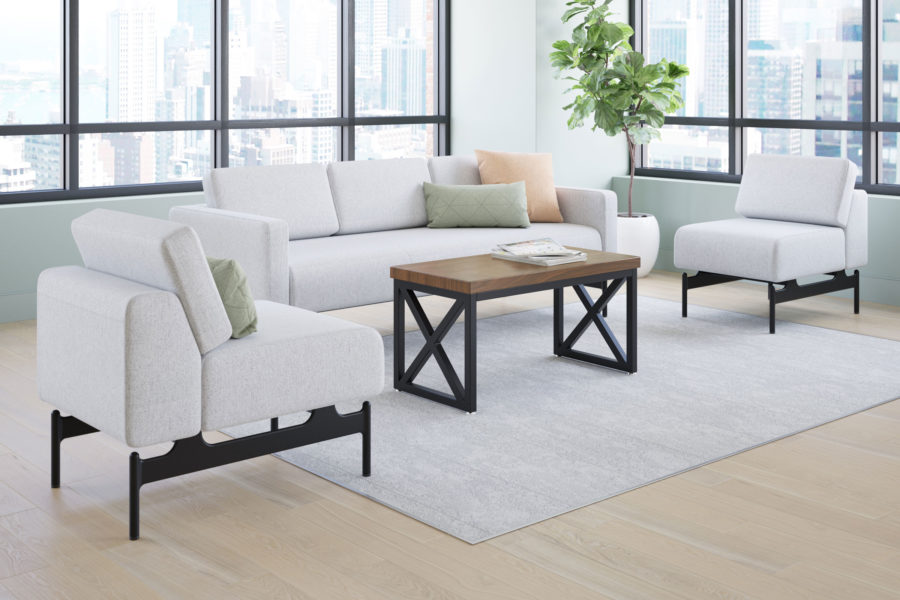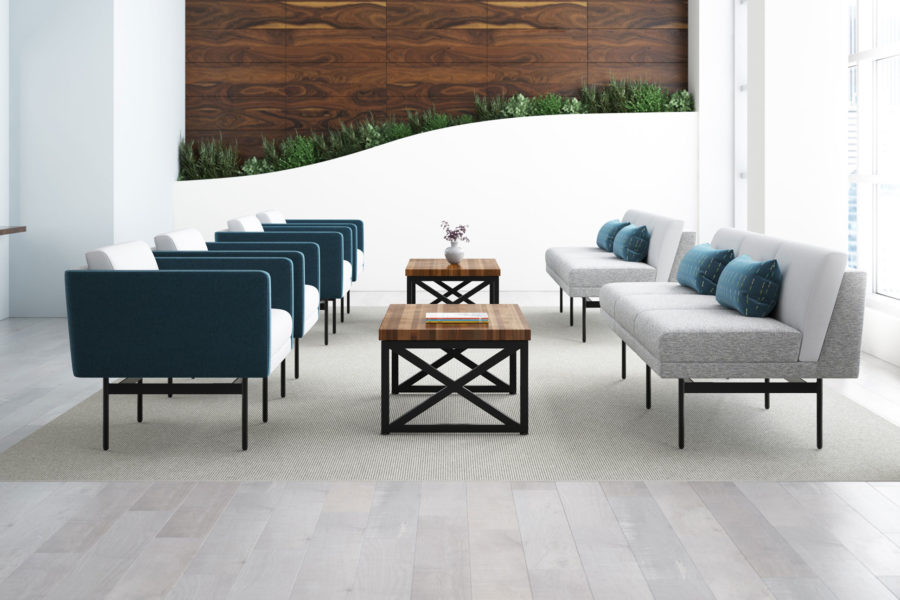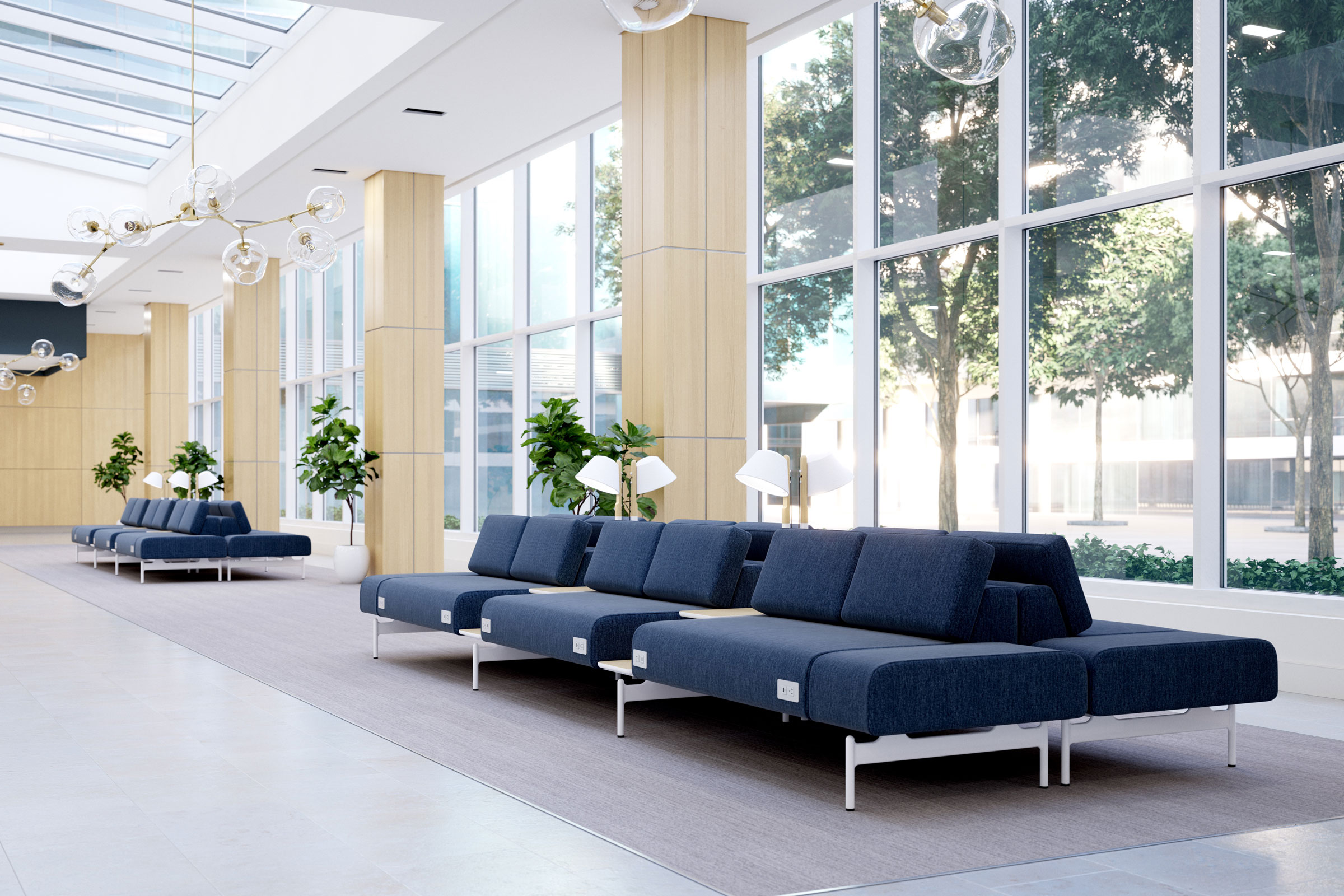Story at a glance:
- Research shows health care design needs an overhaul. Kimball International is offering even more flexible design with Interwoven.
- Solutions like Embra are modular, freestanding, and modern—able to adapt to meet a variety of needs across settings.
- Whittaker Health also supports flexible design as it can be used in a waiting room, vaccination space, classroom, or other setting.
The waiting room. Most of us have had an uncomfortable experience there at some point or another. The old-school hospital or clinic space with uncomfortable chairs ganged together, forcing you to sit too close to someone coughing. And that’s just one awkward example of many.
“Environments should be designed to be agile or mobile,” says Kim Montague, Kimball International’s executive director of applied research and partnerships. Kimball International recently rolled out research with independent company DesignIntelligence that looks at responsive design, including how health care spaces can be designed more flexibly.
Montague, a trained architect who’s worked in health care design for more than 30 years, says this research revealed three major findings—that physical environment has a major effect on patients’ physical and emotional outcomes, in-home health care and virtual services are in ever-increasing demand, and caregiver burnout is worse than ever.
“We know we need to design these spaces to better accommodate future unknown change,” Montague says. “So how do we design a space that allows these health care systems to change and accommodate social distancing, testing, education, or whatever might be needed in the future?”

Embra, from Interwoven (a brand of Kimball International). “We think of space differently, because there’s no point in solving a problem with a product until you understand the problem in the space,” says Aneetha McLellan, executive director of design and innovation at Kimball. Photo courtesy of Interwoven
These efforts begin with looking at how to provide more versatile settings with positive distractions that encourage movement—a proven way to minimize stress, Kimball International says. This can include seated and standing-height tables that give people the choice to isolate or engage, seating with conveniently located outlets, and even lockers for more security.
Montague says 72.7% of respondents—that includes doctors and nurses—surveyed for this research reported that the physical environment plays a significant role in outcomes for patients, caregivers, and family. Just think back to the start of the pandemic, when visiting hours were first seriously restricted. “We heard a lot of sad stories of patients who passed away with only an iPad a caregiver shared with them. It was a very impersonal experience,” she says. “It affects the emotional outcome for caregivers and the family members of that patient. They were distraught.”
Aneetha McLellan, executive director of design and innovation at Kimball International, also looks back to the start of the pandemic. It was then that her team quickly launched “Design Thinking for a New Workday,” looking at how the pandemic would inform future design. “There hadn’t been much focus in acute settings in a very long time,” McLellan says. “Health was prepared after 9/11 for a one-day emergency event; they were not prepared for a multi-year event that has highs and lows. Our infrastructure was never set up for this, and it shows. You shouldn’t have to turn people away who’ve been in a car accident because of Covid.”
They turned back to a model called “acuity adaptable,” a topic that was hot 10 years ago but faded away because it’s expensive, McLellan says. Until now. “Can you imagine if you had 500 beds in a hospital and only 80 are ICU. What if you could pivot so all 500 could be ICU? We don’t build things like that. We say we do, but we don’t. That’s where design and innovation comes in.”

A modular line collection, Whittaker Health combines light and slender volumes with a sophisticated industrial aesthetic. Photo courtesy of Interwoven
Interwoven, a brand of Kimball International, already offers a whole host of flexible health care furniture products, including the mobile Aidin table, and new products are in development to allow for even more flexibility. They also have products like Alterna, a modular caseworks solution. “We can design such that the casework will adapt and change for any future need. You can design it with space for a monitor to be put on the wall to accommodate a virtual care encounter,” Montague says.
Kimball International says settings that balance consultation with exam needs often lead to a better outcome, too. One hybrid solution may include designing for a more comfortable, residential living room setting that reduces stress and invites conversation. But even in a more traditional exam room, flexibility is key. Kimball International’s findings indicate that you can improve the process by providing a place for additional caregivers and family to join in the delivery of care, replace the exam table with a comfortable and versatile patient recliner, and make for a more open, spacious feel by using wall-mounted supply cabinets.
According to the American Medical Association in 2016, 70% of patient encounters don’t even need an exam table. So why have one in every room? You could opt for more mobile, comfortable seating options like Interwoven’s Meadow or Greer recliners instead and always move them later if needed. Innovative products continue to be designed thanks to the ongoing research, which has even revealed the ideal seat height—18 inches.

Meadow is a comprehensive, full function patient recliner designed to fit all patient body types and sizes. Photo courtesy of Interwoven
Montague says Interwoven’s Embra and Whittaker Health product lines also support flexible design—allowing for quick transformation from, say, what some would call a waiting room (Kimball International calls it a multipurpose or community room because who likes to wait?) into space for vaccination, testing, or even education. “Think about those community spaces as more than just a space to come in and wait for 20 mins before the doctor calls you into the clinic,” she says.
Embra—modern, freestanding, modular community seating—can be easily reconfigured and stands in stark contrast to some health care furniture of old. Montague recalls one recent conversation with a nurse-turned-interior designer. This individual works for a large health system and found herself trying to figure out how she could possibly break up some massive, ganged seating in an emergency room. “They ended up busting up the seating with a sledgehammer and bringing in folding chairs because they had to create social distancing,” Montague says.
Better design for behavioral health is another emphasis, and McLellan is excited by some of Interwoven’s latest innovations in this arena. “For some reason in the industry anything that has to do with any behavioral issues has a stigma and isn’t treated like a disease like cancer or heart disease,” she says. “We are studying in great detail how we can develop and provide products that emphasize human dignity.”
Interwoven’s Spruce and Joelle lines, while not meant for high acuity, are an example of the possibilities, as they’re ligature-resistant with concealed parts. “They don’t look like behavioral health furniture, and that’s the point. With small modifications, you can dignify a person.”


